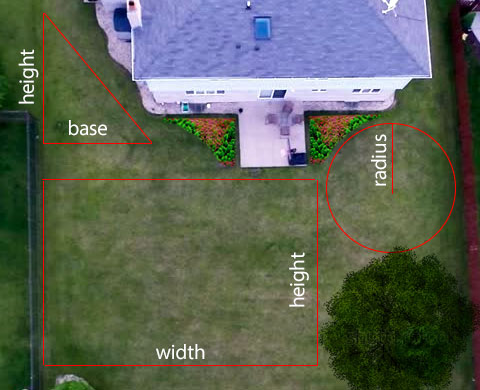Laying sod can be a significant time and money investment. By getting it right the first time you will save time, money, and headaches in the future. Check out top tips from our experts below and get your project rolling in no time.
- What is the best time of year to lay sod?
- How to calculate how much sod your project needs
- Preparing your site for sod installation
- Steps to laying sod: DIY or hire a professional?
- New sod care tips including summer installations
1. What Is the Best Time of the Year to Lay Sod?
You can lay sod anytime during the growing season, as long as the ground is not frozen and you have adequate water for establishment and maintenance. Spring and early autumn are best when the cool temperatures combined with occasional rain help sod quickly root. However, if you are installing during the summer, you’ll need to take certain precautions, such as watering deeply, adjust your fertilizing times, and watch for fungal growth.
2. Calculate How Much Sod Your Project Needs
So, you’re ready to order your sod, but do you know how much you will need? To calculate how much sod to order, follow these simple steps below:
- Sketch the area to be sodded. Divide the space into squares, rectangles, triangles, and circles.
- Measure each area (length x width) and calculate square footage.
- Total all the measurements using our easy sod calculator, adding 5-10% for cutting and shaping around your landscape.
Alternatively, you can use a GPS service and walk the area you want to measure using your smartphone and calculate your total square feet.
Save yourself time and money: Measure twice, order once!
3. Prepare the Site for Sod Installation
Now that you know how much sod you need and have placed your order, it’s time to prepare for the sod installation. Proper site preparation is a key component to success, additionally, your site should essentially be prepared the same, regardless of how you choose to establish your lawn. Here’s a cheat sheet to set up your site:
- Clear the site: Remove all debris, including rocks, stumps, and building materials, to a depth of at least 2-3 inches.
- Grade and drain: Rough grade the area to eliminate drainage issues, sloping away from foundations. Fill in low-lying areas and reduce severe slopes.
- Prepare the soil: Till the soil to a depth of 4-6 inches, or 2 inches if adding topsoil. Add high-quality topsoil to achieve a depth of 4-6 inches after firming. Test soil pH and amend as needed.
- Finish grading: Finish grading the site, maintaining slopes, and ensuring a smooth surface.
- Fertilize and settle: Apply a starter fertilizer, such as 18-23-12, at the recommended rate. Roll the area with a lawn roller to settle the surface and fill in any low spots. Allow the site to settle further with rainfall or irrigation before installation.
4. Best Practices for DIY Sod Installation
Did you know there’s a proper way to lay sod for optimal growth and appearance? Follow the steps below to install your sod the correct way.
- Install your sod immediately after delivery. Depending on how hot and humid the weather is, rolled sod may heat up and begin to ferment.
- To establish your first row of sod, start at a straight edge like a walkway or driveway.
- Begin by laying the sod in a brickwork fashion, smoothing the soil in advance of sod laying. Make sure the joints are butted together snugly without overlapping. If laying sod on slopes, lay the slabs perpendicular to the hill.
- Use a sharp knife to cut and shape sod around curves, trees, and borders.
- If available, you can roll installed sod with a light roller one-third filled with water to smooth out any minor bumps, remove air pockets, and improve sod-to-soil contact. Avoid using a heavy roller that will compact the site.
Don’t want to or can’t install your new sod yourself? Saratoga Sod Farm can help! We offer professional sod installation throughout New York, New Jersey, New Hampshire, Massachusetts, Connecticut, and Vermont from April to December! Request a quote online or give us a call at 518.664.5038.
5. Tips for New Sod Care Including Summer Installations
Watering New Sod
Begin watering newly laid sod immediately after installation, then follow the tips below. If you have a larger area, do not wait until the end of the day to begin watering. Once a section is completed, water it thoroughly.
- You are transplanting a live plant! Water the newly installed sod deeply and thoroughly immediately after installation.
- Water at least twice a day (morning and afternoon) for the first few weeks to establish roots.
- Water in the morning when wind speeds are lower and water loss is minimal. Avoid evening/overnight watering, especially in hot, humid weather, to prevent disease and fungus.
- Gradually reduce watering frequency as the sod begins to root into the soil.
- Once the sod is well-established (several weeks after installation), water deeply and infrequently to encourage deep root growth and drought tolerance.
Mowing New Sod
Your new sod can be mowed when it looks like it needs mowing, approximately one to two weeks after installation, depending on the time of year. Be sure to follow these guidelines:
- When possible, use a walk-behind power mower with the cutting height set high, at least 3 inches. Do not use a riding mower as it is too heavy, and its powered wheels can tear up the new sod. Be sure the ground/grass is not too wet.
- After the sod has fully rooted (approximately three weeks), regular mowing can commence. For best results, never cut more than 1/3 of the grass blade per mowing and maintain sharp mower blades. Keep a height of cut of at least 3” during hot weather, and stay off the grass if it is dry and stressed.
- Cutting frequency will need to be increased during the faster-growing seasons of spring and fall. Grass clippings may be left on the lawn to return nutrients to the root zone, as long as they are light and don’t clump.
Fertilizing New Sod
To ensure that your turf remains healthy, feed your lawn 3-4 times during the growing season. A slow-release or controlled-release form of Nitrogen should be used whenever possible, especially on the spring and fall applications. Be sure to always follow the manufacturer’s recommendations and ultimately “water-in” fertilizer after each application.
Trust the Experts with Your Sod Installation Needs
Saratoga Sod Farm is a proud grower, supplier, and installer of high-quality natural turfgrass sod to commercial and residential clients in NY & the Northeast. For pricing, installation services, DIY advice, or any questions about sod, get in touch with us today!



